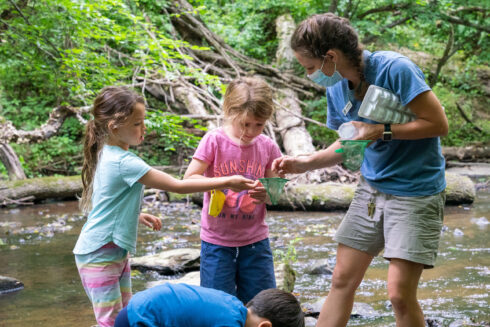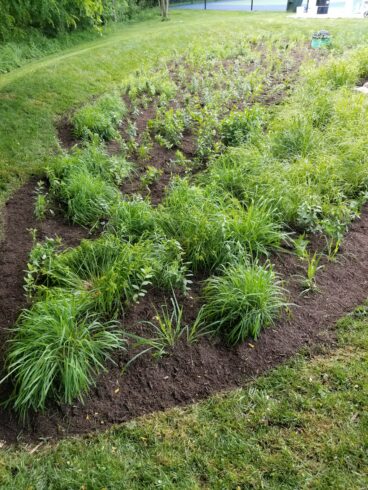National Pollutant Discharge Elimination System (NPDES)
Montgomery Parks (Parks) is regulated by the National Pollutant Discharge Elimination System (NPDES) Phase II Municipal Separate Storm Sewer System (MS4) Permit. An MS4 is simply a system of conveyances (e.g. curbs, gutters, storm drains, etc.), that is owned or operated by a state, city, or other public entity that carries and collects stormwater and is not part of a sewage treatment plant. This permit regulates stormwater discharges and requires the development of a range of stormwater management programs and best practices aimed at eliminating nutrient and sediment pollution from stormwater.
To accomplish this, Parks implements best management practices (BMPs) under 6 six minimum control measures that are laid out in the permit:
- Public or Personnel Education and Outreach
- Public or Personnel Involvement and Participation
- Illicit Discharge Detection and Elimination
- Construction Site Runoff Control
- Post-Construction Stormwater Management
- Pollution Prevention and Good Housekeeping
Practices implemented under these minimum control measures serve to reduce or eliminate sources of stormwater pollution on parkland in Montgomery County. As stewards of Montgomery County’s most significant tributaries to the Chesapeake Bay, Montgomery Parks’ mission and operational responsibilities support the goals of the MS4 permit to reduce stormwater pollution; educate and involve the public; and coordinate with other MS4 permittees along the way.
This permit is administered by the Maryland Department of the Environment (MDE). Each year, a report is submitted to MDE that covers progress towards meeting the goals of the NPDES program within the permit term. The most recent annual report can be seen in the Resources tab on the right, and contains specific details and accomplishments over the last fiscal year related to each of the minimum control measures discussed below. Previous years’ annual reports can be requested by contacting Kyndal Gehlbach, Parks’ NPDES MS4 Coordinator.
Personnel Education and Outreach
Permittees are required to implement and maintain a public and/or personnel education and outreach program and distribute education materials to the community and/or employees to help reduce the discharge of pollutants caused by stormwater runoff. To accommodate the range of responsibilities within Montgomery Parks, personnel educational and outreach material is tailored specifically to each Division within the Department and is disseminated through presentations, hands-on training, e-mails, and daily conversations. As a professionally diverse organization, in-house staff education programs establish a baseline of knowledge, convey management goals to staff, and provide job-relevant information on a variety of environmental topics.
Public Involvement and Participation

The public or personnel involvement and participation program is designed for the target audience of park users. This program includes initiatives such as park and stream clean-ups, non-native invasive plant removal projects, nature center programs, storm drain murals, and engagement events for all ages. Adult stewards can be trained as Cleanup Leaders, Weed Warrior Supervisors, Master Naturalists, and Volunteer Community Scientists. These programs empower leaders to educate others on the impacts of uncontrolled stormwater pollution to waterways, as well as to collect data to help evaluate aquatic habitat conditions. Montgomery Parks staff members also work closely with community members and local watershed groups, involving them in efforts that help meet the goals of the MS4 permit.
Illicit Discharge Detection and Elimination (IDDE)
Knowledge of existing storm drain infrastructure is critical to understanding the potential travel corridors for pollutants from their source, to our streams. As a park system with nearly 500 miles of streams to steward, the amount of storm drain infrastructure on Parkland is extensive. Montgomery Parks implements a program to detect and eliminate illicit discharges by inspecting outfalls on parkland to screen for and eliminate potential illicit discharges to streams. Outfalls with higher potential for illicit discharge, such as those located in urbanized areas and at park maintenance yards, are prioritized for screening. Montgomery Parks’ staff proactively screen a number of outfalls on an annual basis to identify any pollution that may be negatively impacting the health of County streams. Staff also respond to reports of suspected pollution, including water and sewer line breaks and illegal dumping.
Construction Site Runoff Control
Montgomery Parks values the importance of proper installation and maintenance of erosion and sediment controls on all construction sites. Park staff review all project design plans for work on Parkland to ensure that sites are designed for adequate stormwater runoff controls. For sites with more than 5,000 sq. ft. of land disturbance, project designs are also reviewed by Montgomery County Department of Permitting Services (MCDPS) before issuance of a sediment control permit. Each construction project on Parkland is assigned an in-house Construction Inspector to monitor progress and ensure that erosion and sediment controls are properly installed and maintained to prevent sediment pollution from exiting the construction site.
Post-Construction Stormwater Management: Facility maintenance

Maintaining stormwater management (SWM) facilities after they are constructed is critical to their proper function. SWM facilities require specialized maintenance at frequent intervals to remain fully functional and safe. There are two categories of SWM facilities on Parkland – facilities for which Montgomery Parks shares maintenance responsibilities with MCDEP, and those for which Montgomery Parks is solely responsible for maintenance. At locations with shared maintenance, MCDEP is responsible for structural maintenance and Montgomery Parks is responsible for non-structural maintenance.
Examples of non-structural maintenance activities include:
- Routine inspections;
- Bioretention mulching, weeding, plant maintenance and replanting;
- Mowing and trash removal for all facilities;
- Debris removal from in-flow and out-flow devices and animal burrow repair in ponds; and
- Sandfilter and infiltration trench weeding, leaf removal, and surface deconsolidation
Examples of structural maintenance activities include:
- Underdrain and riser repair;
- Retrofits; and
- Dredging/sediment removal
Some SWM facilities provide habitat acceptable and beneficial for wildlife. However, wildlife can also negatively impact the structural integrity and function of these stormwater facilities. Beavers, groundhogs, and Canada geese can all create significant maintenance, operational, structural and public safety issues. Routine inspections are conducted in and around stormwater facilities by Montgomery Parks’ stormwater inspectors and wildlife ecologists. If wildlife species are confirmed to be causing damage to facilities or impeding their function, staff will undertake measures to mitigate the impacts.
Post-Construction Stormwater Management: SWM Retrofit Projects on Parkland
Park Development Division project managers and designers consistently work to maximize the treatment of stormwater runoff within the scope of their Park project designs. Meanwhile, staff engineers work in collaboration with natural resources staff to identify opportunities to retrofit existing parks to better manage and treat stormwater where water quality benefits can be maximized, and natural resource impacts minimized. Restoration retrofits funded by Parks’ Capital Improvements Program (CIP) include bioswales, bioretentions, infiltration trenches, rain barrels, enhanced outfalls, and pond improvements. Underutilized paved areas are converted to pervious surfaces and vegetated when possible.
Some areas along Parks’ stream valleys and within floodplains are inappropriate for traditional SWM facilities, yet still receive untreated stormwater runoff and convey it directly into stream channels. In order to break up the flow path and allow for settling and treatment of pollutants, these sites are graded to lengthen flow paths with a series of berms and the creation of microtopography that provides varying depths of water retention. Native wetland vegetation and large woody debris are incorporated to create habitat for pollinators, amphibians, and other native wildlife.
Pollution Prevention and Good Housekeeping
Other initiatives pursued on Parkland that share the goal of reducing and eliminating stormwater pollution include reforestation, wildlife management, fertilizer use limitations, restricted use of pesticides near waterbodies and eliminating pesticide use on playgrounds. Additionally, reforestation occurs through Fee-in-Lieu (compensatory mitigation for damages to the environment), PEPCO, and WSSC projects on Parkland.
The 12 maintenance yards operated by Montgomery Parks are continually maintained and inspected under NPDES Industrial permits (General Discharge Permit No. 12-SW, the NPDES General Permit for Discharges from Stormwater Associated with Industrial Activities). Each maintenance yard is also inspected annually by a qualified staff member alongside the appropriate park manager, during which reports are generated and any required corrective actions identified and implemented. Stormwater Pollution Prevention Plans (SWPPPs) for each maintenance yard are updated annually by staff to reflect current conditions, operations, and personnel.
Managing Stormwater in Parks: Complementary to the Mission
Montgomery Parks is comprised of over 36,000 acres containing nearly 500 miles of stream channels and over 29,000 acres of open and environmentally preserved spaces that provide both valuable natural areas and recreational opportunities. Even prior to the issuance of Parks’ first NPDES MS4 permit in 2004, and continuing through today, activities on Parkland contribute toward mitigating the negative effects of stormwater pollution in Montgomery County streams and ultimately the Chesapeake Bay. Parks is committed to the implementation of a variety of SWM BMPs which enhance our programs and further our mission, in addition to fulfilling our permit requirements.